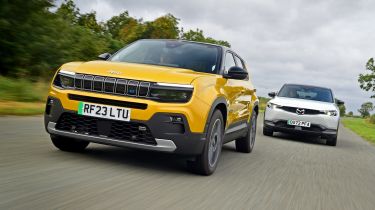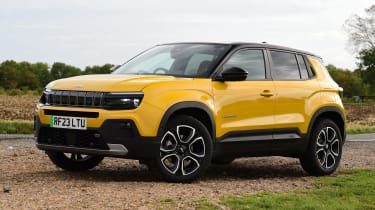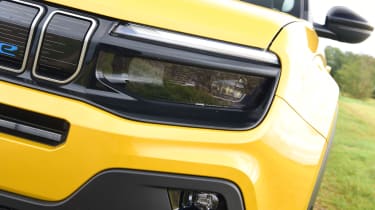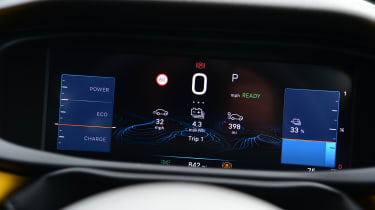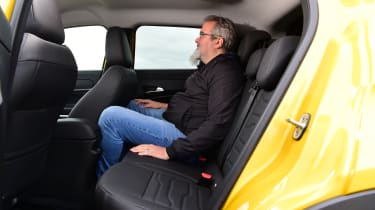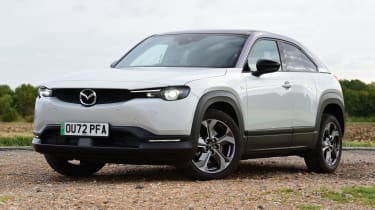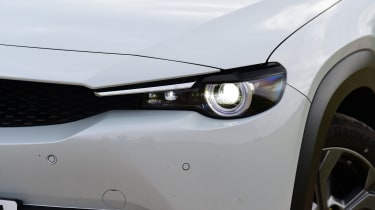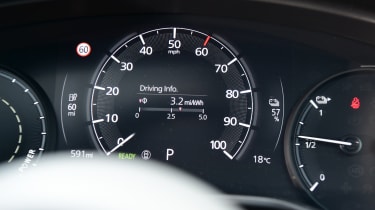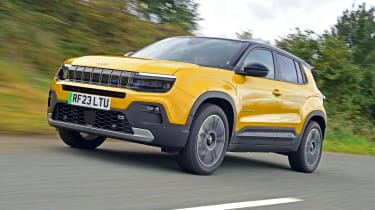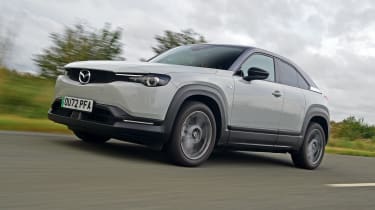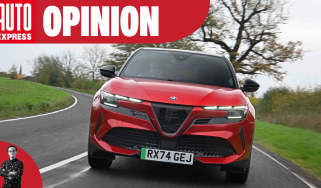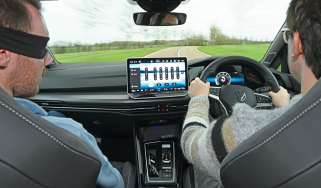Jeep Avenger vs Mazda MX-30: left-field electric SUVs face off
The Avenger electric SUV is on a mission to grow Jeep sales – how does it fare against the Mazda MX-30?
Times are changing. Until recently, Jeep traded on the ability of its cars to reach parts others couldn’t, but under the umbrella of the Stellantis group, it’s on a mission to break new ground and boost the brand’s market share.
One of the first cars to arrive as part of Jeep’s range expansion is the Avenger small electric SUV. Although it’s new, it uses plenty of traditional Jeep styling cues, but the latest electric running gear means it has a battery range that could make it an appealing choice in the class.
One car that isn’t quite so competitive for range, but certainly matches the newcomer for style, is the Mazda MX-30. The Japanese model offers something different in the small SUV class, and while the rotary-equipped range extender is making plenty of headlines at the moment, it’s the full-electric model we’re testing here.
Can the Avenger deliver more than funky looks? And does the MX-30 offer enough style and versatility to cancel out the handicap of its limited range?
Jeep Avenger
| Model: | Jeep Avenger Summit |
| Price: | £39,600 |
| Powertrain: | 1x e-motor, 154bhp |
| 0-62mph: | 9.6 seconds |
| Test efficiency: | 4.3 miles/kWh |
| Test range: | 219 miles |
| Annual VED: | £0 |
While the Avenger is the smallest car in Jeep’s line-up, its electric powertrain contributes to a starting price of £35,700. This top-spec Summit costs £39,600, although options including leather trim and metallic paint with a contrasting roof colour bump our test car’s price up to £42,425.
Tech highlights
Jeep is a newcomer to the small electric SUV class, but the tech under the bodywork is familiar. That’s because the Avenger uses the same STLA small platform as cars such as the Peugeot E-2008 and Vauxhall Mokka Electric, and it benefits from the second-generation EV technology that they have.
Used - available now

2020 Ford
Focus
32,494 milesAutomaticDiesel1.5L
Cash £12,500
2017 Citroen
C1
62,492 milesManualPetrol1.0L
Cash £5,399
2021 Tesla
Model 3
38,764 milesAutomaticElectric
Cash £17,497
2023 Hyundai
Tucson
27,029 milesManualPetrol1.6L
Cash £17,397That means a 54kWh battery with an 11kW charging system is fitted, while the electric motor sends 154bhp and 260Nm of torque to the front wheels. Where the Avenger diverges from its relatives within the Stellantis group is in terms of size. At 4,084mm, the Avenger is 311mm shorter than the Mazda here, and is only slightly longer than a VW Polo supermini, making the Avenger one of the smallest cars in the class.
What the Jeep lacks in size it makes up for with style, because it uses the company’s familiar design cues, such as the seven-bar grille, squared-off wheelarches and body-coloured C-pillars. There are lots of ‘Easter eggs’ in the design, too, such as the mountain peak that surrounds the rear wiper, a compass set into the lower front grille, and stylised Jeep logos dotted around outside. In some ways these neat touches remind us of a MINI.
Safety: The Avenger hasn’t been tested by Euro NCAP yet, but uses the same tech as other STLA-based models. However you will have to choose top-spec Summit trim for advanced kit such as adaptive cruise with lane centring, a rear camera and auto main beam.
On the road
Jeep’s ability to build capable off-roaders is a given, but the Avenger feels accomplished on tarmac.
Around town: With its compact dimensions and relatively high driving position, the Avenger is well suited to urban driving. Light controls make it a doddle to manoeuvre, while the electric motor provides plenty of low-speed response.
There are three drive modes – Eco, Normal and Sport – and in the default Normal setting, power is limited to 110bhp, although this is more than enough for town use and preserves battery range. Switch to the Eco mode and power drops to 80bhp, but the lack of power is counter-productive because you work the motor harder to make progress.
As with other Stellantis EVs, the Avenger has a ‘B’ mode which boosts the brake regeneration when lifting off, so you only really need to touch the brakes when coming to a complete halt.
A & B-roads: Most of the time, Normal mode is fine on faster roads, too, while switching to the Sport setting sees throttle response become snappier, which takes a bit of getting used to. If you’re in Normal mode and need the extra power for an overtake, there’s an auto-style ‘kickdown’ in the pedal travel that unlocks maximum power.
The Avenger’s steering is quick, while the ride is well resolved, with limited body roll in corners and good grip. Bumps are dealt with well, while the Avenger’s relatively low kerbweight means it feels nimble when compared with other EVs.
Motorway: This agility doesn’t come at the expense of refinement at higher speeds, where the Avenger feels stable and comfortable. There’s not much wind noise, while even the 18-inch wheels don’t have much of an impact on cabin noise.
Ownership
From behind the wheel, the Avenger feels like a small car, but not one that feels cramped. There’s a good range of adjustment for the driver’s seat, while the view forward is good. The flat bonnet will cause reflections in some light situations, although Jeep offers a matt-black bonnet graphic as an accessory if it bothers you.
The rear view isn’t quite so good, with a narrow back window and thick C-pillars limiting visibility. However, all Avengers come with rear parking sensors, while a reversing camera is standard on Summit cars, and an option on other trims.
Cabin quality is a mixed bag. Other Jeeps use hard plastics to make a point about their ruggedness, but this doesn’t really work in the Avenger and it feels lower rent next to the Mazda here. However, the Jeep’s coloured dashboard trim gives the interior a lift, the screens look smart, and the multifunction steering wheel is good to hold and easy to use.
Additionally, the various little design details dotted around the car help to counter the use of familiar Stellantis switchgear in other places.
Efficiency: Where the Avenger steals a march over its rival here – and a lot of other small SUVs – is with its efficiency. The Jeep returned 4.3 miles per kWh during our time with it, and that included a couple of longer motorway runs; keep your speed down, and we’d expect to see even better figures. Either way you should be able to cover 200 miles on a full charge without issue.
Faster on-board charging tech means that while the Avenger has a bigger battery than the Mazda, it takes a similar time to top up, with a 20-80 per cent DC charge at 100kW taking 24 minutes.
We tested these two cars in late summer when the temperatures were in the high teens and low 20s, but both cars feature heat pumps as standard, which will limit the reduction in range when temperatures drop.
Practicality
The Avenger is small and compromised for passengers, but boot space is fine.
Rear Space: The main factor limiting the Avenger’s appeal is the small rear seats. Headroom isn’t an issue, but legroom will be tight against the seatbacks for taller passengers.
The platform’s combustion-engined roots mean there’s a transmission tunnel that eats into foot room, while a ridge in the floor beneath the front seats limits space, too. The middle rear seat is quite narrow, so having three passengers on board will be tight.
Boot: The Avenger’s short length means there’s not much of a rear overhang, but boot space is reasonable. At 341 litres, it’s a match for most superminis, and is bigger than the MX-30’s by nine litres. The space is square and flat, while the back seats are simple to fold.
What to buy?
Which version we’d choose
- Powertrains: There’s a single option for the electric Avenger, with a 154bhp motor and 54kWh battery.
- Trim: The three-model line-up comprises Longitude, Altitude and Summit specs, and all cars come with LED lights, Apple CarPlay and Android Auto, rear parking sensors and a full suite of safety kit.
- Options: There are different packs depending on which trim you choose. The Infotainment & Convenience Pack on Longitude and Altitude trims adds kit that’s standard on Summit for £1,000 and £800 respectively.
- Our choice: Altitude trim has all the kit you could want and won’t break the bank.
Mazda MX-30
| Model: | Mazda MX-30 Makoto |
| Price: | £35,550 |
| Powertrain: | 1x e-motor, 143bhp |
| 0-62mph: | 9.7 seconds |
| Test efficiency: | 3.6 miles/kWh |
| Test range: | 124 miles |
| Annual VED: | £0 |
In an effort to make its first full EV affordable, Mazda has fitted the MX-30 with a small 35.5kWh battery. Prices are certainly competitive, with the range starting from £31,250. Even this top-spec Makoto version undercuts the entry-level Avenger by £150.
Tech highlights
The Mazda MX-30 dwarfs the Avenger here in every dimension, and it’s one of the bigger cars to be classed as a small SUV. In fact, its overall length, wheelbase and width are identical to the combustion-engined Mazda CX-30, so like that car it sits in a part of the sector somewhere between small and compact SUVs – other rivals include the Volkswagen T-Roc and Toyota C-HR.
Of course, the big difference with the MX-30 is its electric powertrain. A battery capacity of 35.5kWh isn’t much bigger than you’ll get in some premium plug-in hybrid SUVs, while a WLTP-certified range of 124 miles is the shortest of any new electric car currently for sale in the UK.
A 143bhp electric motor sends drive to the front wheels, while a 0-62mph time of 9.7 seconds is only a tenth of a second behind the more powerful Jeep here. As ever, there’s an automatic gearbox, but the Mazda’s drive selection lever is more conventional than the Avenger’s push-button set-up.
Safety: Euro NCAP awarded the MX-30 a five-star safety score in 2020, and it comes with a host of safety systems as standard. All cars feature blind-spot monitoring, lane assist with lane-departure warning, road-sign recognition and driver attention alert, while Makoto models also add front cross-traffic alert and smart brake support for when you’re reversing.
The Jeep Avenger has yet to be tested by Euro NCAP, but comes with a similarly long list of safety kit.
On the road
Constant awareness of the MX-30’s limited range spoils any driving enjoyment. Which is a shame, because it has plenty to offer.
Around town: Thanks to that short range, the Mazda is going to do its best work around town where speeds are kept low. Light steering means it’s easy to manoeuvre at lower speeds, while standard-fit front and rear parking sensors go some way to make up for the car’s small glass area.
The MX-30’s low-speed ride is on the firm side when compared with the Avenger’s, even though the Jeep is fitted with slightly lower-profile tyres on similarly sized 18-inch wheels.
A & B-roads: Pick up the pace, and the firm edge to the MX-30’s ride translates into better body control than the Jeep in corners, where it feels more stable. This stiffer set-up means the Mazda is more engaging to drive, but it comes at the expense of the car’s ride, which is firm at all speeds.
Put your foot down, and the MX-30’s electric motor tends to build pace rather than give you a shove in the back like some other EV set-ups – including the Avenger here when it’s in Sport mode. At least that means the range isn’t impacted too hard every time you floor the throttle.
As with the Jeep, there’s energy recuperation on offer, which is controlled via paddles behind the MX-30’s steering wheel. However, the system is counter-intuitive, with the ‘+’ setting offering two levels of coasting, and ‘–’ boosting energy recovery. The latter isn’t as strong as Jeep’s ‘B’ mode, though.
Motorway: The MX-30 is well behaved at higher speeds, although you will see a drop in range the faster you go. A top speed of just 87mph makes it harder to deplete the battery, though.
Ownership
Before you climb aboard the MX-30, you need to negotiate its other significant talking point – the doors. The front ones are conventional, although they can be opened to a 90-degree angle to boost access to the front seats. However, it’s the rear ‘half doors’ that are of greater interest.
If you’re getting in the back and are unfamiliar with the layout, you might not notice the internal handle that releases the back-hinged door, and you’ll be cursing the lack of space to get in. Open them, and access to the back seats is clear of door pillars, but tall adults will still need to move the front seats forward to get the best access.
One quirk of the Mazda’s specification is that the driver’s seat has electric adjustment to make more space, but the passenger seat doesn’t. Once in, you’ll need to half step out again so you can reach the handle to close the door. And of course, it’s impossible to get back out of the rear seats before somebody opens the front doors first. With such a fiddly layout, and a relative lack of space, the MX-30 could grow to be a pain to live with if it was used as family transport.
Mazda has a decent reputation with owners, as evidenced by its seventh-place finish in our most recent Driver Power satisfaction survey. Jeep didn’t appear in the latest poll, but past results haven’t been particularly favourable, although the company will be hoping its four-year Jeep Shield after-sales package will boost the Avenger’s appeal.
Storage: A pair of cork panels on the centre console flip up to reveal cup-holders, while the MX-30’s armrest bin is deeper than the Avenger’s. The Mazda’s raised centre console makes space for a storage shelf ahead of it, while the front door bins are of a decent size, and so is the glovebox.
In the back, the half doors have slim pockets, which is more than the Avenger offers, because there are no pockets at all in the Jeep’s rear doors.
Practicality
While the MX-30 is bigger overall than the Avenger, cabin space is similar to that in the smaller machine.
Rear Space: Once in the back seats, you’ll find less headroom in the MX-30 than in the Avenger, but legroom is similar, although that means there’s not much on offer, while foot space under the front seats is tighter, too. The Mazda’s cabin is narrower, so travelling three-up will be cosy, while the small fixed back windows add to the claustrophobic feel.
Boot: A capacity of 332 litres lags behind the Avenger, and some of that space is taken up by a bag containing the charging cable – as with the Jeep, there’s no room under the bonnet for storage.
Folding the back seats creates 1,137 litres of space, which is 84 litres ahead of the Jeep, but if you’re tall beware that the tailgate doesn’t open very high.
What to buy?
Which version we’d choose
- Powertrains: As with the Avenger, there’s just one motor and battery combination available in the MX-30.
- Trim: Prime-Line, Exclusive-Line and Makoto trims are the three versions available, and all feature standard kit including climate control, adaptive cruise, auto LED headlights, front and rear parking sensors and touchscreen infotainment with built-in navigation.
- Options: If you want more kit, then you’ll need to move up a level, because the only options are paint and part-leatherette upholstery for Makoto trim.
- Our choice: The entry-level Prime-Line model doesn’t feel short-changed on kit.
Results
Which car comes out on top?
Winner: Jeep Avenger
| Pros | Cons |
| Efficient powertrain | Cramped back seats |
| Comfortable ride | Average boot space |
| Appealing looks | Poor rear visibility |
| Four-year Jeep Shield | Pricey in top spec |
The Avenger is a charming little car that has plenty of appeal in terms of looks, equipment and driving ability. If you don’t need space to carry passengers, then it could be all the electric SUV you need.
In a way it reminds us of the MINI hatch, with its style making up for its less practical elements. However, the efficient powertrain, competitive range and decent chassis mean the Avenger has substance, while Jeep’s complimentary four-year after-sales package makes its higher price easier to swallow.
Runner up: Mazda MX-30
| Pros | Cons |
| Upmarket cabin design | Short range |
| Well equipped for the price | Awkward back-seat access |
| Entertaining handling | Small boot |
| Competitive finance | Firm ride |
If you only do short journeys and are able to charge the MX-30 every time it’s parked, then its limited range won’t be an issue. However, the car’s quirky door arrangement hampers its versatility, while the space on offer is no better than you’ll find in the Avenger, despite the Mazda being a larger car.
Still, the MX-30 has lots of kit for a price tag that undercuts the Avenger’s, and it’s made even more attractive by Mazda’s current zero per cent finance offer.
Which would you buy? Let us know in the comments section below…
Specs & prices
| Jeep Avenger Summit | Mazda MX-30 Makoto | |
| On the road price/total as tested | £39,600/£42,245 | £35,550/£35,550 |
| Residual value (after 3yrs/36,000) | £20,374 (51.5%) | £12,620 (35.5%) |
| Depreciation | £19,226 | £22,930 |
| Annual tax liability std / higher rate | £158.18/£316.40 | £142/£284 |
| Annual elec. cost (10k / 20k miles) | £628 (£1,256) | £750 (£1,500) |
| Ins. group / quote / VED | 25/£994/£0 | 19/£905/£0 |
| Service costs (3 years) | £0 | £399 |
| Length/wheelbase | 4,084/2,562mm | 4,395/2,655mm |
| Height/width | 1,528/1,776mm | 1,555/1,795mm |
| Powertrain | Front e-motor/lithium-ion battery | Front e-motor/lithium-ion battery |
| Peak power | 154bhp | 143bhp |
| Peak torque | 260Nm | 271Nm |
| Transmission | Single-speed auto/fwd | Single-speed auto/fwd |
| Battery capacity / usable | 54/51 kWh | 35.5/35.5 kWh |
| Boot capacity (seats up / down) | 341/1,053 litres | 332/1,137 litres |
| Kerbweight | 1,540kg | 1,645kg |
| Turning circle | 10.5 metres | 11/4 metres |
| Basic warranty / recovery | 3 years (60,000 miles)/3 years | 3 years (60,000 miles)/3 years |
| Driver Power manufacturer position | N/A | 7th |
| Euro NCAP: Adult / child / ped. / assist / stars | N/A | 91/87/68/73/5 (2020) |
| 0-62mph / top speed | 9.6 seconds/93mph | 9.7 seconds/87mph |
| Claimed range (WLTP) | 246 miles | 124 miles |
| Charging capability | 2.3/11/100kW | 2.4/6.6/50kW |
| Charging time | 26h 41min/5h 34 min/24 min (20-80%) | 15h 8min/5h/26 min (20-80%) |
| Number of airbags/Isofix points | Six/two | Six/two |
| Parking sensors/camera | Front, rear & side/rear | Front & rear/360 |
| Lane-keep assist/blindspot/AEB | Yes/yes/yes | Yes/yes/yes |
| Climate control/adaptive cruise ctrl | Yes/yes | Yes/no |
| Leather/heated seats | £1,200 (+power)/front/no | Part fake/yes/yes |
| Metallic paint/LED lights | £1,100/yes | £550/yes |
| Keyless entry & go/powered tailgate | Yes/yes | Yes/no |
| Sat-nav/digital dashboard/USBs | £500/yes/two | Yes/yes/one |
| Online services/wireless charging | Yes/yes | Yes/yes |
| Apple CarPlay/Android Auto | Yes/yes | Yes/yes |

